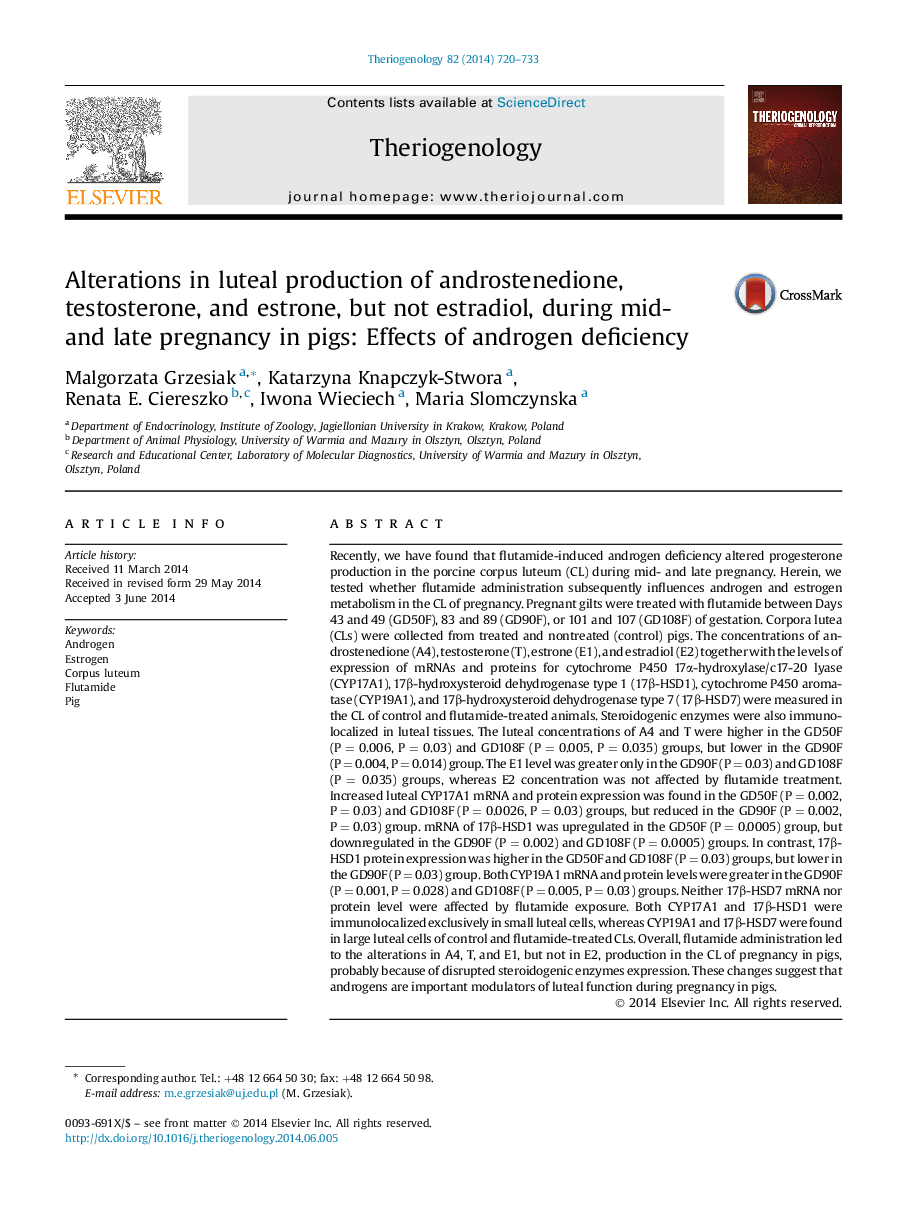| Article ID | Journal | Published Year | Pages | File Type |
|---|---|---|---|---|
| 10891889 | Theriogenology | 2014 | 14 Pages |
Abstract
Recently, we have found that flutamide-induced androgen deficiency altered progesterone production in the porcine corpus luteum (CL) during mid- and late pregnancy. Herein, we tested whether flutamide administration subsequently influences androgen and estrogen metabolism in the CL of pregnancy. Pregnant gilts were treated with flutamide between Days 43 and 49 (GD50F), 83 and 89 (GD90F), or 101 and 107 (GD108F) of gestation. Corpora lutea (CLs) were collected from treated and nontreated (control) pigs. The concentrations of androstenedione (A4), testosterone (T), estrone (E1), and estradiol (E2) together with the levels of expression of mRNAs and proteins for cytochrome P450 17α-hydroxylase/c17-20 lyase (CYP17A1), 17β-hydroxysteroid dehydrogenase type 1 (17β-HSD1), cytochrome P450 aromatase (CYP19A1), and 17β-hydroxysteroid dehydrogenase type 7 (17β-HSD7) were measured in the CL of control and flutamide-treated animals. Steroidogenic enzymes were also immunolocalized in luteal tissues. The luteal concentrations of A4 and T were higher in the GD50F (P = 0.006, P = 0.03) and GD108F (P = 0.005, P = 0.035) groups, but lower in the GD90F (P = 0.004, P = 0.014) group. The E1 level was greater only in the GD90F (P = 0.03) and GD108F (P = 0.035) groups, whereas E2 concentration was not affected by flutamide treatment. Increased luteal CYP17A1 mRNA and protein expression was found in the GD50F (P = 0.002, P = 0.03) and GD108F (P = 0.0026, P = 0.03) groups, but reduced in the GD90F (P = 0.002, P = 0.03) group. mRNA of 17β-HSD1 was upregulated in the GD50F (P = 0.0005) group, but downregulated in the GD90F (P = 0.002) and GD108F (P = 0.0005) groups. In contrast, 17β-HSD1 protein expression was higher in the GD50F and GD108F (P = 0.03) groups, but lower in the GD90F (P = 0.03) group. Both CYP19A1 mRNA and protein levels were greater in the GD90F (P = 0.001, P = 0.028) and GD108F (P = 0.005, P = 0.03) groups. Neither 17β-HSD7 mRNA nor protein level were affected by flutamide exposure. Both CYP17A1 and 17β-HSD1 were immunolocalized exclusively in small luteal cells, whereas CYP19A1 and 17β-HSD7 were found in large luteal cells of control and flutamide-treated CLs. Overall, flutamide administration led to the alterations in A4, T, and E1, but not in E2, production in the CL of pregnancy in pigs, probably because of disrupted steroidogenic enzymes expression. These changes suggest that androgens are important modulators of luteal function during pregnancy in pigs.
Related Topics
Life Sciences
Agricultural and Biological Sciences
Animal Science and Zoology
Authors
Malgorzata Grzesiak, Katarzyna Knapczyk-Stwora, Renata E. Ciereszko, Iwona Wieciech, Maria Slomczynska,
